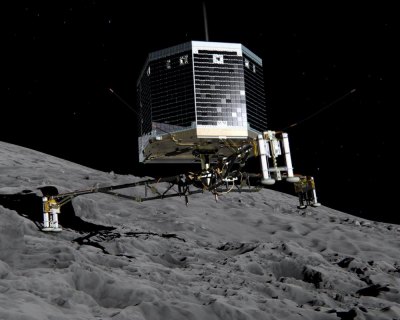European Space Agency probe lands on comet

A European probe landed on a comet. Artist's concept: ESA.
The signal confirming touchdown on the surface of Comet 67P/Churyumov–Gerasimenko arrived on Earth at 5:03 p.m. Central European Time – 11:03 a.m. Eastern time in the U.S.
Rosetta launched in March 2004 and traveled 6.4 billion kilometers (more than 3.9 billion miles) through the solar system before arriving at the comet in August of this year.
A NASA official called it a great day for space exploration.
“The data collected by Rosetta will provide the scientific community and the world with a treasure-trove of data. Small bodies in our solar system like comets and asteroids help us understand how the solar system formed and provide opportunities to advance exploration,” said John Grunsfeld, astronaut and associate administrator for NASA’s Science Mission Directorate in Washington.
Images of the comet reveal boulders, towering cliffs and daunting precipices and pits, with jets of gas and dust streaming from the surface.
Earlier this year, the ESA held a contest to name the landing site. The winning entry was Agilkia, after Agilkia Island, on the Nile River in the south of Egypt. A complex of ancient Egyptian buildings, including the famous Temple of Isis, was moved to Agilkia from the island of Philae when the latter was flooded during the building of the Aswan dams in 20th century. Agilkia was one of the most popular entries in the competition. It was proposed by more than 150 participants.
During the next two to three days, the lander will conduct its primary science mission. An extended science phase using a rechargeable secondary battery may be possible, assuming sun illumination conditions are good and dust settling on the solar panels does not prevent it. This extended phase could last until March 2015, after which conditions inside the lander are likely to be too hot for it to continue operating.
Researchers expect a full panoramic view of the landing site, high-resolution images of the surface underneath the lander and an analysis of the composition of the comet’s surface materials.
The comet will reach its closest distance to the sun in August 2015 -- about 185 million kilometers (115 million miles) -- roughly between the orbits of Earth and Mars. Rosetta will follow it throughout the remainder of 2015.
This story was compiled from European Space Agency and NASA reports.
Related:

